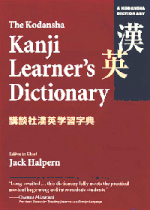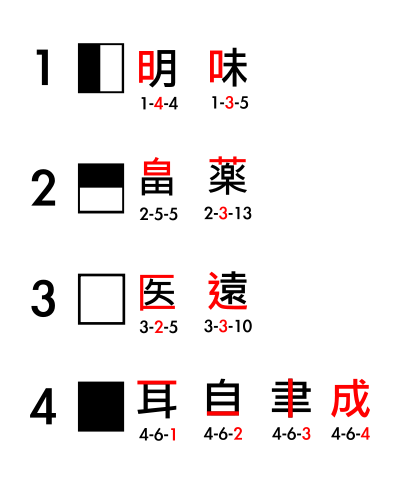Kodansha Kanji Learner's Dictionary
The Kodansha Kanji Learner's Dictionary is a kanji dictionary based on the New Japanese-English Character Dictionary by Jack Halpern at the CJK Dictionary Institute and published by Kenkyūsha. Originally published in 1999 (with a minor update in 2001), a revised and updated Second Edition was issued on 2013, reflecting the new changes in the Joyo Kanji mandated in 2010. This Revised and Expanded Edition increases the number of kanji entries from 2,230 to 3,002, as well as changing all pronunciations from romanji to kana. There also exists electronic forms of this dictionary for both iOS and Android. A more extensive version of this dictionary by the CJK Dictionary Institute is also published by Kodansha called the Kodansha Kanji Dictionary.

The dictionary arranges entries according to an original system called SKIP (System of Kanji Indexing by Patterns). The dictionary also has indexing by radical and character readings.
SKIP

The SKIP method used by the Kodansha Learner's Dictionary is an original system for indexing kanji, meant to be accessible to those who have no prior knowledge of them. Instead of organizing kanji based on radicals, they are organized based on pattern. Based on how a kanji can be divided into sections, they are grouped into four main categories: Left-Right (1), Up-Down (2), Enclosure (3), and Solid (4). Users then count the number of strokes in each segment, and use them to determine the kanji's SKIP number. Since December 12, 2014, the SKIP coding system and all established SKIP codes have been released for public use under a Creative Commons licence.
Determining SKIP numbers
1) Left-Right
Left-Right kanji are those which can be broken down into sections segmented vertically such as 明 (bright), which can be broken down into the left segment 日 (sun) and the right segment 月 (moon). Thus, 明 would be in the first main category (Left-Right), would have four strokes in its left segment and four in its right, giving it a SKIP number 1-4-4.
In the above example, the kanji can be broken down into two segments, both of which are actual radicals, but such does not need to be the case. The kanji 測 (measure) can be broken down into three segments 氵 (water), 貝 (shell money), and 刂 (knife). In such cases, the leftmost discrete element is treated as the left segment, and the rest of the kanji as the right segment. Therefore, 測 is split into the left segment of 氵and the right segment of 則 (rule), and the resulting SKIP number is 1-3-9.
2) Up-Down
Up-Down kanji are kanji that can be broken down into sections segmented horizontally such as 男 (male), which can be broken down into the up segment 田 (rice field) and the down segment 力 (power). Thus, 男 would be in the second main category (Up-Down), would have five strokes in its up section and two strokes in its down section, giving it a SKIP number of 2-5-2.
Again, the up and down sections do not necessarily need to be radicals, and can consist of more than two segments. The kanji 薬 (medicine) can be split into three segments. In such cases, the topmost discrete element is the up segment, while the remainder of the kanji (楽) is the down segment. Thus, 薬 has a SKIP number of 2-3-13.
3) Enclosure
Enclosure kanji are those where one element borders or surrounds other elements of the kanji. Such elements can border other elements on two sides (近 and 症), three sides (風 and 区), or completely surround the other elements (囲). In SKIP numbers for enclosure kanji, the bordering element’s stroke count comes first, followed by the stroke count of the elements inside the enclosure. Thus, the SKIP number of 風 (wind) is 3-2-7.
4) Solid
Solid kanji are kanji that cannot be easily broken down into elements based on the patterns of the other categories. Often these kanji are formed from a single radical. Solid kanji are broken down into four sub-patterns:
- Top line – Kanji which have a prominent horizontal stroke at the top, e.g. 耳 (ear) and 子 (child).
- Bottom line – Kanji which have a prominent horizontal stroke at the bottom, e.g. 上 (up) and 丘 (hill).
- Through line – Kanji which have a prominent vertical stroke through the middle, e.g. 本 (book) and 中 (middle).
- Others – Kanji which cannot be placed in the preceding sub-patterns, e.g. 女 (woman) and 丸 (circle).
SKIP numbers for Solid kanji follow the following pattern: 4 (the main category) – (the stroke count for the entire kanji) – (the number of the sub-pattern). Thus, the SKIP number of 子 is 4-3-1 and the SKIP number for 本 is 4-5-3.
Aids in searching
In its index for kanji, pages where a user might erroneously expect a kanji to be located (either because of incorrect classification or incorrect stroke count) are cross-referenced with their correct SKIP number.
References
- Halpern, Jack, ed. (2013). Kodansha Kanji Learner's Dictionary (Revised and Expanded ed.). New York, NY: Kodansha America. ISBN 1-5683-6407-5.CS1 maint: extra text: authors list (link)
- Halpern, Jack, ed. (2013). Kodansha Kanji Dictionary (Revised and Expanded ed.). New York, NY: Kodansha America. ISBN 1-5683-6408-3.CS1 maint: extra text: authors list (link)
See also
- Four corner method, a structural encoding for Chinese characters